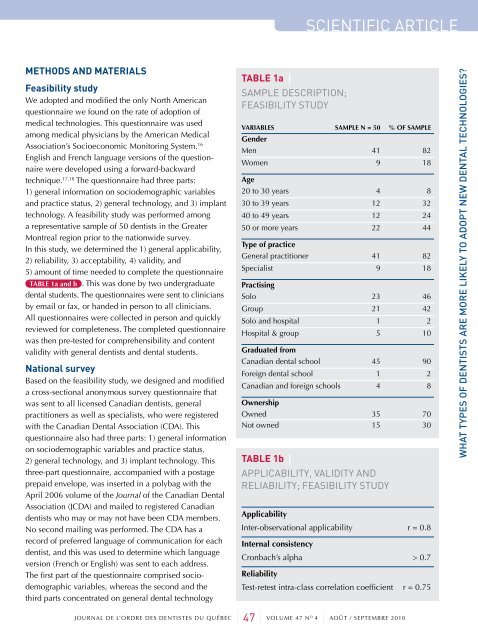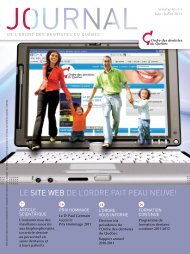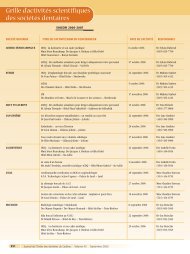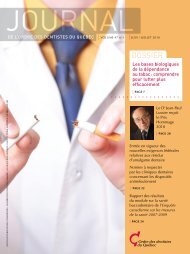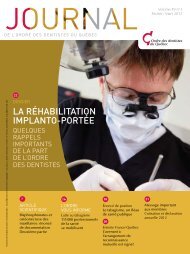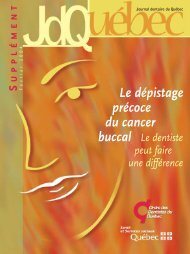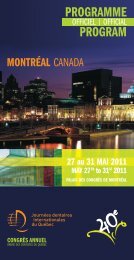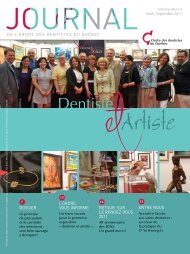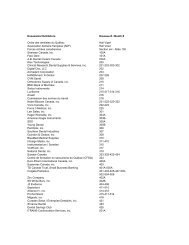Août / septembre 2010 - Ordre des dentistes du Québec
Août / septembre 2010 - Ordre des dentistes du Québec
Août / septembre 2010 - Ordre des dentistes du Québec
Create successful ePaper yourself
Turn your PDF publications into a flip-book with our unique Google optimized e-Paper software.
METHODS AND MATERIALS<br />
Feasibility study<br />
We adopted and modified the only North American<br />
questionnaire we found on the rate of adoption of<br />
medical technologies. This questionnaire was used<br />
among medical physicians by the American Medical<br />
Association’s socioeconomic Monitoring system. 16<br />
English and French language versions of the questionnaire<br />
were developed using a forward-backward<br />
technique. 17,18 The questionnaire had three parts:<br />
1) general information on sociodemographic variables<br />
and practice status, 2) general technology, and 3) implant<br />
technology. A feasibility study was performed among<br />
a representative sample of 50 dentists in the Greater<br />
Montreal region prior to the nationwide survey.<br />
in this study, we determined the 1) general applicability,<br />
2) reliability, 3) acceptability, 4) validity, and<br />
5) amount of time needed to complete the questionnaire<br />
tABLE 1a and b . This was done by two undergra<strong>du</strong>ate<br />
dental students. The questionnaires were sent to clinicians<br />
by email or fax, or handed in person to all clinicians.<br />
All questionnaires were collected in person and quickly<br />
reviewed for completeness. The completed questionnaire<br />
was then pre-tested for comprehensibility and content<br />
validity with general dentists and dental students.<br />
National survey<br />
based on the feasibility study, we <strong>des</strong>igned and modified<br />
a cross-sectional anonymous survey questionnaire that<br />
was sent to all licensed Canadian dentists, general<br />
practitioners as well as specialists, who were registered<br />
with the Canadian dental Association (CdA). This<br />
questionnaire also had three parts: 1) general information<br />
on sociodemographic variables and practice status,<br />
2) general technology, and 3) implant technology. This<br />
three-part questionnaire, accompanied with a postage<br />
prepaid envelope, was inserted in a polybag with the<br />
April 2006 volume of the Journal of the Canadian dental<br />
Association (JCdA) and mailed to registered Canadian<br />
dentists who may or may not have been CdA members.<br />
No second mailing was performed. The CdA has a<br />
record of preferred language of communication for each<br />
dentist, and this was used to determine which language<br />
version (French or English) was sent to each address.<br />
The first part of the questionnaire comprised sociodemographic<br />
variables, whereas the second and the<br />
third parts concentrated on general dental technology<br />
TABLE 1a |<br />
SAMPLE DESCRIPTION;<br />
FEASIBILITy STUDy<br />
SCIENTIFIC ARTICLE<br />
vARiABLES SAMPLE n = 50 % oF SAMPLE<br />
Gender<br />
Men 41 82<br />
Women 9 18<br />
Age<br />
20 to 30 years 4 8<br />
30 to 39 years 12 32<br />
40 to 49 years 12 24<br />
50 or more years 22 44<br />
type of practice<br />
General practitioner 41 82<br />
specialist 9 18<br />
Practising<br />
solo 23 46<br />
Group 21 42<br />
solo and hospital 1 2<br />
Hospital & group 5 10<br />
Gra<strong>du</strong>ated from<br />
Canadian dental school 45 90<br />
Foreign dental school 1 2<br />
Canadian and foreign schools 4 8<br />
ownership<br />
Owned 35 70<br />
Not owned 15 30<br />
TABLE 1b |<br />
APPLICABILITy, VALIDITy AND<br />
RELIABILITy; FEASIBILITy STUDy<br />
Applicability<br />
inter-observational applicability r = 0.8<br />
internal consistency<br />
Cronbach’s alpha > 0.7<br />
Reliability<br />
Test-retest intra-class correlation coefficient r = 0.75<br />
JOUrNAL dE L’OrdrE dEs dENTisTEs dU qUébEC | 47 | VOLUME 47 NO 4 | AOûT / sEpTEMbrE <strong>2010</strong><br />
WhaT TYpES OF DENTISTS aRE MORE LIKELY TO aDOpT NEW DENTaL TEChNOLOGIES?


